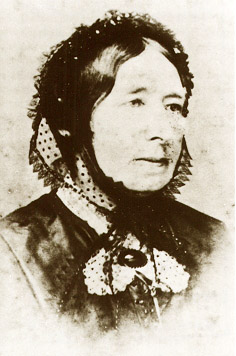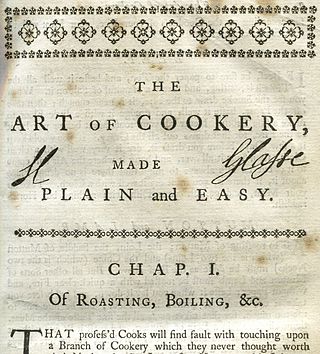Nathan Bailey, was an English philologist and lexicographer. He was the author of several dictionaries, including his Universal Etymological Dictionary, which appeared in some 30 editions between 1721 and 1802. Bailey's Dictionarium Britannicum was the primary resource mined by Samuel Johnson for his Dictionary of the English Language (1755).

A cookbook or cookery book is a kitchen reference containing recipes.

Bakewell pudding is an English dessert consisting of a flaky pastry base with a layer of sieved jam and topped with a filling made of egg and almond paste.

Ratafia is a broad term used for two types of sweet alcoholic beverages, a flavouring essence whose taste resembles bitter almonds, later to a ratafia flavoured biscuit, a biscuit to be eaten along with ratafia, and later still, to a cherry variety.

Johanna Friederika Henriette Katharina Davidis was a German cookbook writer. Although many similar cookbooks had been published by then, amongst others Sophie Wilhelmine Scheibler's Allgemeines deutsches Kochbuch für bürgerliche Haushaltungen in several editions, Davidis' Praktisches Kochbuch became the reference cookbook of the late 19th and early 20th century, a standard in German households. The large number of second-hand copies still available, frequently heavily annotated, are proof that the books were in much use. In many families Praktisches Kochbuch was handed down through the generations.

Martha Moore Ballard was an American midwife, healer, and diarist. Unusual for the time, Ballard kept a diary with thousands of entries over nearly three decades, which has provided historians with invaluable insight into colonial frontier-women's lives.

Hannah Glasse was an English cookery writer of the 18th century. Her first cookery book, The Art of Cookery Made Plain and Easy, published in 1747, became the best-selling recipe book that century. It was reprinted within its first year of publication, appeared in 20 editions in the 18th century, and continued to be published until well into the 19th century. She later wrote The Servants' Directory (1760) and The Compleat Confectioner, which was probably published in 1760; neither book was as commercially successful as her first.
Jane Sharp was an English midwife. Her work The Midwives Book: or the Whole Art of Midwifery Discovered, published in 1671, was the first on the subject to be produced by an Englishwoman.

The Compleat Housewife; or, Accomplish'd Gentlewoman's Companion is a cookery book written by Eliza Smith and first published in London in 1727. It became popular, running through 18 editions in fifty years.
A gentlewoman in the original and strict sense is a woman of good family, analogous to the Latin generosus and generosa. The closely related English word "gentry" derives from the Old French genterise, gentelise, with much of the meaning of the French noblesse and the German Adel, but without the strict technical requirements of those traditions, such as quarters of nobility.

Eliza Leslie, frequently referred to as Miss Leslie, was an American author of popular cookbooks during the nineteenth century. She also wrote household management books, etiquette books, novels, short stories and articles for magazines and newspapers.

Bread and butter pudding is a traditional bread pudding in British cuisine. Slices of buttered bread scattered with raisins are layered in an oven dish, covered with an egg custard mixture seasoned with nutmeg, vanilla, cinnamon or other spices, then baked.

Hannah Woolley, sometimes spelled Wolley, was an English writer who published early books on household management; she was probably the first person to earn a living doing this.

Elizabeth Raffald was an English author, innovator and entrepreneur.

A New System of Domestic Cookery, first published in 1806 by Maria Rundell, was the most popular English cookery book of the first half of the nineteenth century; it is often referred to simply as Mrs Rundell, but its full title is A New System of Domestic Cookery: Formed Upon Principles of Economy; and Adapted to the Use of Private Families.

No-knead bread is a method of bread baking that uses a very long fermentation (rising) time instead of kneading to form the gluten strands that give the bread its texture. It is characterized by a low yeast content and a very wet dough.

Maria Eliza Rundell was an English writer. Little is known about most of her life, but in 1805, when she was over 60, she sent an unedited collection of recipes and household advice to John Murray, of whose family—owners of the John Murray publishing house—she was a friend. She asked for, and expected, no payment or royalties.

The Cooks and Confectioners Dictionary: or, the Accomplish'd Housewives Companion was a cookery book written by John Nott and first published in London in 1723.

Mary Eales was a writer of the cookery and confectionary book Mrs Mary Eales's Receipts, published in 1718. The little that is known about her life is from the title pages of the various editions of her book.

Martha Bradley was a British cookery book writer. Little is known about her life, except that she published the cookery book The British Housewife in 1756 and worked as a cook for over thirty years in the fashionable spa town of Bath, Somerset.















